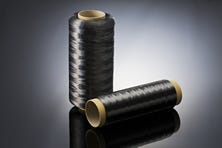Mitsubishi Plastics, Inc. (Tokyo) and Mitsubishi Rayon Co., Ltd. (Tokyo) plan to integrate their carbon fiber businesses that are, respectively, pitch-based and PAN-based. The merger will take place on April 1, 2015 with the establishment of a new entity by Mitsubishi Rayon. The combined entity will have revenue estimated at over $500 million and is targeting sales of over $850 million by 2018.
January 22, 2015
Mitsubishi Plastics, Inc. (Tokyo) and Mitsubishi Rayon Co., Ltd. (Tokyo) plan to integrate their carbon fiber businesses that are, respectively, pitch-based and PAN-based. The merger will take place on April 1, 2015 with the establishment of a new entity by Mitsubishi Rayon. The combined entity will have revenue estimated at over $500 million and is targeting sales of over $850 million by 2018.
|
Pitch-based carbon fiber market could expand through merger of Mitsubishi Group companies. |
The two companies under the Mitsubishi Chemical Holdings Corporation group will constitute the world's only manufacturer with both coal pitch-based carbon fiber and PAN-based carbon fiber technologies. Tangible results have already been achieved to date by the two sister companies including a series of newly designed golf shafts developed by Mitsubishi Rayon through the use of both PAN-based and pitch-based carbon fibers. Further developments combining both carbon fiber types are anticipated in the fields of automotive, pressure vessels and wind turbines and through this, the new Mitsubishi entity aims to differentiate itself from competitors such as market leader Toray Industries (Tokyo). In particular, a pitch/PAN-based carbon fiber composite may prove suitable for structural components in automobiles.
Mitsubishi Plastics commands a dominant global position in the pitch-based carbon fiber business, with an approximately 71% share of worldwide capacity according to the company, although the global market for these fibers is only around 1% of that for PAN-based fibers. Pitch-based fibers are employed in applications such as industrial machinery, bridge reinforcement, and satellites. PAN-based fibers, on the other hand, find use in aircraft, automobiles, and wind turbine blades.
You May Also Like



